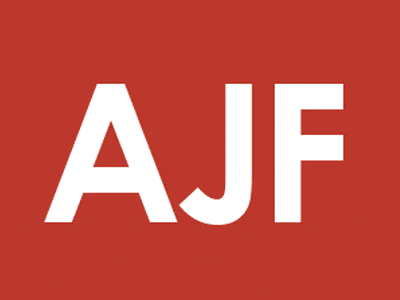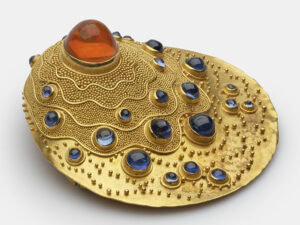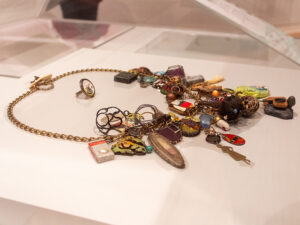Dans la ligne de mire. Scènes du bijou contemporain en France
September 20, 2013–March 2, 2014
Musée des Arts Décoratifs, Paris, France
Circuits bijoux, parcours du bijou contemporain (“Jewel circuit, a route/itinerary of contemporary jewelry”) is one of the most ambitious cultural events concerning contemporary jewelry to take place in the past 10 years in Europe, all the more unexpected as France does not have a strong presence on the international contemporary jewelry scene. Its basic organization lies on the simple “concept” of a delocalized event through different places in Paris, consisting of at least 60 different exhibitions and several series of lectures. Ambitious, challenging, and plural, the event is the outcome of the patient collaboration and partnership of galleries, museums, and other creation-related places and organizations. The production and programming need to be commended. It involved a great deal of knowledge, work, selection, contacts, and the important task of coordinating several “prestigious” places.
Ateliers Arts de France, the Musée des Arts Décoratifs, and the association D’un bijou à l’autre (literally “From one jewel to another”) organized the event with the idea of providing a plural panorama of creators and creation in the world of contemporary jewelry. Within this framework, one of the central exhibitions is Dans la ligne de mire. Scènes du bijou contemporain en France. (Ligne de mire is the French military expression for “line of fire” but can also be translated as “line of vision.” The rest of the title translates as “stages of contemporary jewelry in France.”) Taking into the account the symbolic importance of the exhibition, the centrality of it, and its prestigious host and partner the Musée des Arts Décoratifs, Dans la ligne de mire has been conceived, curated, and presented as the key exhibition of the manifestation.
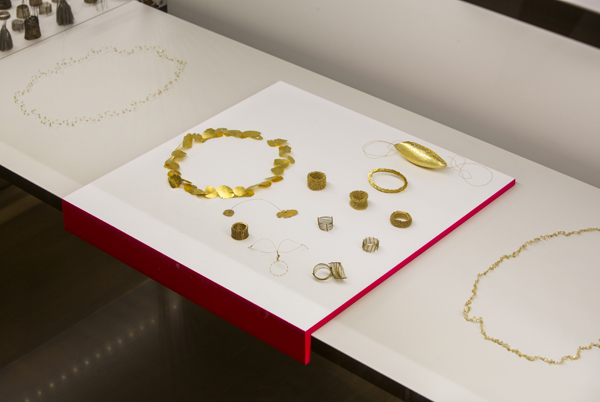
The second choice is to mix four different jewelry genres or provenances in the selection. The visitor is thus given the possibility to appreciate: “independent contemporary creators” (37 artists represented); “installations” (a special focus on the worlds of seven artists); “haute bijouterie et joaillerie” (three prestigious luxury haute-jewelry maisons or houses); and finally, “bijou de couture et métiers de la parure” (costume and fashion jewelry, represented through nine maisons and their creators’ works). This rather bold choice means that Ligne de Mire is less endogamous than most other shows in the Circuit du Bijou, which focus solely on contemporary jewelry. It would have been extremely interesting, in fact, had better mediation allowed visitors to parse the differences and similarities between these genres. But that’s another debate.
Judging the pertinence of the choices of individual artists and their creative universes would be a sterile exercise, but I will give my impression of the show and make a few observations on the grounds of the specific evolution of, and the debates surrounding, the stage of contemporary jewelry.
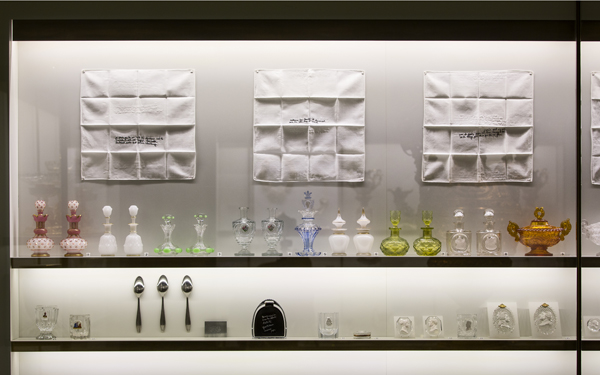
The museum, the superb collection, the range of artists, the aesthetic universes, and works selected and displayed, will interest most curious art aficionados, erudite minds, and jewelry lovers, including the trendy Parisian socialites who seem to be the sociological target of the exhibition (the one the discourse of the exhibition is implicitly, but clearly, addressing). Be that as it may, let us say plainly to evacuate the simple question of appreciation, that the exhibition is highly interesting, aesthetically challenging, and rich, whoever’s point of view we may adopt.
Let me engage with the most immediate and physical aspect of the show, namely the question of the integration of contemporary pieces among the scenography of the permanent collection. The success of this choice very clearly hinges on the effect of contrast. Here, contrast is not only a powerful means of subversion of traditional styles of exhibiting, but also a way of producing new aesthetic reactions to what is exhibited. Paradoxically, I am under the impression that the curators wanted to suggest to the public the question of continuity: continuity of arts, of certain forms, but above all, continuity of a national heritage, of prestige, of national grandeur. The whole museum is a place that honors and praises the art français, understood as luxury creations by generations of subtle and master craftsmen appointed to satisfy the ruling class’s caprices and follies.
Of course, “contrast scenography,” if I may call this curatorial strategy by that name, has already been tried and tested (by Bodet himself, amongst others, in a ceramics exhibition organized three years ago in the same museum, and which serves as a museographical reference for Ligne de Mire). Its main mechanism is to play on the confrontation of two seemingly opposed objects to create or favor the sensation of tension, disharmony, or difference. The main objective of this aesthetic confrontation is, to my sense, to simultaneously provoke a multiple aesthetic appreciation of the universes confronted (say, for example, a contemporary and a medieval artwork). The confrontation, the effects of which I shall presently discuss, provides a very interesting experience, and the curators need to be acknowledged for their choice of not separating the “old” from the “new.”

Some of these confrontations are cruel. This was my experience of the work of well-known artist Monika Brugger and a disposition of three pieces from her series of textile work titled Blessures (2008-13). Although the intellectual context for the work as a re-appropriation of traditional medieval ouvrages de femmes (women’s textile work) and its reference to women’s menstruations really interested me personally, the visitors’ attention was inevitably distracted away from Brugger’s installation by the strong and charged presence of the magnificent medieval works surrounding it. Going back to our initial question (does contrast museography systematically work?), my point is that however good the works of Brugger and her contemporaries are, they often simply lack the presence that older works have, so this uneven battle often makes them look anecdotal and reframes their discursive strategies as a pose in spite of their true aesthetical qualities. In the context of the museum, what makes this work “contemporary” often seems highly narcissistic and small.
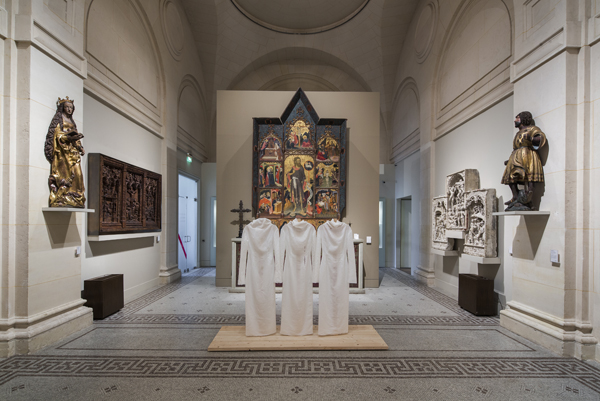
Mediation, Contemporary Jewelry, and “Artification”[1]
Maybe the success of the contrast with older and more traditional work also hinges on the use of mediation, the formal discursive instruments that embody or sustain the presentation of the pieces (wall texts, captions, catalogue essays). In my opinion, the fact that this jewelry is so reliant on textual appendages to control, signal, retain, or impose (rather unsuccessfully) certain meanings or interpretations is unexpected, not to say paradoxical, in the wider context of jewelry. The paradox lies in the fact that jewelry is, among the many crafts, one of the most exposed to the phenomenon of appropriation by the most concrete uses of all, bodily use. Jewelry was one of the last artistic spaces spared the discursive trend linked with contemporary art ethos.
What happens to some of those pieces when mediation is not there to institute or signal the artist’s will? Some resist, and some fall entirely into a form of opaque, merely physical existence, not necessarily even aesthetic. Perhaps it’s the strength of the exhibition to allow all these possible questions and answers in the same space, for a plural aesthetic experience. It also opens the mental space of analysis, to reframe the experience over time, after the visit.
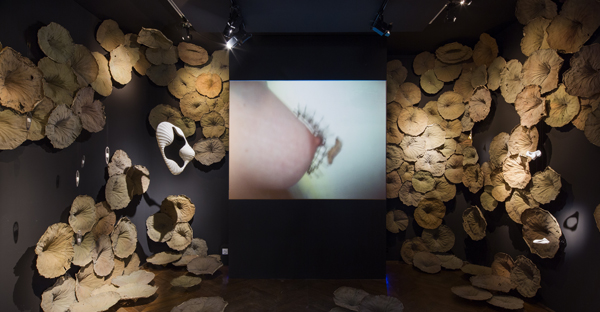
In a conversation with some artists present at the show, some mentioned the notion of “repulsive pieces,” which is interesting because it signals that contemporary jewelry has entered a form (a game?) of experimentation similar to well known forms and discourses of contemporary art as it re-interprets the aesthetic program of the twentieth century’s avant-gardes. It is tempting, for example, to view Emmanuel Lacoste’s series CARNE (Meat) in the light of Baudelaire’s seminal poem Une Charogne (a Carcass).
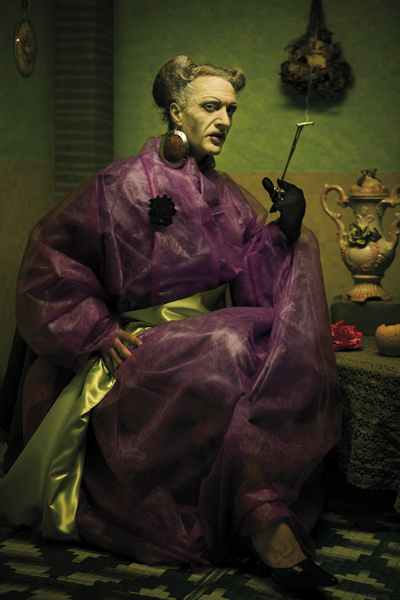
I do not intend to comment on the displays of great maisons (Chanel, Hermes, and others) and their creators, some of which, of course, also show great artistry and craftsmanship. The whole museum and part of the exhibition seems like a celebration of their own perceived importance, socially and aesthetically, for reasons other than purely aesthetic. They mainly serve as a bridge between old spectacular skill (the permanent collection) and the work of some contemporary jewelers, and in this sense, they provide the symbolic continuity mentioned above, legitimizing the true mission of the institution. Rather than commenting on this, I would like to conclude by focusing on the richest (and more interesting) questions raised by this show, namely the possible definition of what contemporary jewelry is, and of what this definition could imply in terms of an aesthetic program.
One needs to understand that the term “definition” points to a political topic, not only a aesthetic one, because it involves several other questions. Those questions concern the status, the public, the target, the economy, and the social and aesthetic ambition of jewelry conceived as both a form of artistic creation and as part of a more general movement of democratization and redefinition of arts forms. As this exhibition successfully demonstrates, contemporary jewelry—as a field, as an ensemble of disciplines, as a complex space of synthesis of artistic and cultural forms—cannot be defined only in terms of the dialectics of the history of jewelry itself or by the official version of this history as supplied by great luxury brands or supermarkets (even if, statistically, they are the most powerful social actors in establishing a certain definition of jewelry).
The most striking characteristic of contemporary jewelry, I would say, is that it has definitively exited the ancient realm of jewelry, luxury goldsmithing, and other spaces were it was traditionally parked. Not only because it has given itself other materials and is trying to invent new forms or other cultural aspects of jewelry involving the body and its representation. The exhibition bears witness to the crisis of ancient categories of classification, and that is good. Following the claims of the twentieth-century avant-gardes, it consecrates the theoretical possibility and the demand for experimentation, and it affirms, as in the other arts, the sovereignty of the artist (for better or for worse). Social relations concerning jewels, the importance of function, the concept of body beauty, materials (and their origins), wearability, these are questions now open to debate.
Contemporary jewelry is thus defined first and foremost as a statement of independence—in the case of this show, I would say mainly from the aesthetic canons of the luxury houses. In other areas of the world, this independence has fueled, in turn, questions about social and cultural representation. Some actors outside Europe have begun to question Eurocentrism in their practice and their economic realities, particularly regarding the question of the artistic relevance of other forms of creation. This questioning has, to a certain degree, also reformulated the different ways to produce jewelry, and whom to address this production. For instance, since the blood diamonds scandal, the not-so-accidental link of jewelry (and the great maisons) to the most violent aspects of capitalist wars for resources—including gold, precious gems, etc.—has also transformed the attitude of artists, and let’s hope for the best, of parts of the public. This is why movements such as Ethical Metalsmiths, and several other interesting networks, such as the Australia-India design platform, Joya viva-Live jewelry across the Pacific, and other initiatives are showing that it is possible not only to practice contemporary jewelry as an aesthetic alternative to the luxury industry, but also, though jewelry, to consciously engage with the wider context of geopolitical and cultural problems. The idea that jewelry can arouse ethical questions is also a powerful open debate for these alternatives. Their critical voice is strong and needs to be heard and expanded.
Unfortunately, those voices, debates, and discussions were totally absent in the Parisian show. The show was nearly systematically determined by the aestheticism criticized by some activists (like Kevin Murray). What this show did do, however, is to reframe the subversive power of the (extremely varied) jewelry presented into a rather sterile dialogue with the “glorious past” (compare to “l’art français”) that leaves concepts of beauty, status, and social relevance untouched by criticism (although there is nothing obvious about their existence). The only exception is the gender dimension, which is intelligently and deeply explored by some of the creators presented. Let’s hope that new dialogues will open, widen, and deepen following this interesting show.
[1] The neologism “artification” has recently been used by sociologists Roberta Shapiro and Nathalie Heinich to describe the processes by which creative objects, pursuits, or activities are getting re-qualified as “art.” See “De l’Artification, Enquètes sur le passage à l’Art”, Éditions de l’EHESS, Paris, 2012.
